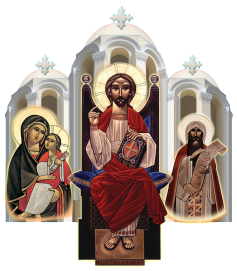During this Nativity Fast, we have been delving into the different Theotokias, which are resounding praises that give us theological insights into the nature of God and the characteristics of St. Mary. Today, we will discuss the refrain in Thursday’s Theotokia, which reads, “He did not cease to be divine, He came and became the Son of Man, for He is the true God, who came and saved us.” Let us contemplate each of the four parts of the verse (also known as “stikhon”):
“He did not cease to be divine”
In the Liturgy of St Gregory directed to the Son of God, the priest describes the Word in the anaphora praising, “indescribable, invisible, infinite, without beginning, everlasting, timeless, immeasurable, incomprehensible, unchangeable.” Since, as St John the Evangelist writes, “God is Love” (1 John 4:8), we can also apply the apophatic1 descriptions of God in the anaphora as a description of His love for us. His love is ineffable in that it is challenging to articulate. It is invisible, operating discreetly. Infinite, without beginning, everlasting, and timeless, because He loved us before the foundation of the world (Ephesians 1:4-6), and His love abides forever. Moreover, His love is immeasurable and incomprehensible; though we acknowledge its existence, our limited understanding struggles to grasp it fully. What’s even more overwhelming is that He continues to love us despite our sins and straying from His path. This unwavering love reminds us of the compassionate Father in the parable of the Prodigal Son (Luke 15:20), who embraces the wayward son with open arms upon his return.
“He came and became the Son of Man”
While in the previous part we acknowledge Christ’s divinity, in this part, we recognize His humanity by saying, “He came and became the Son of Man.” In Philippians 2:6-7 St Paul writes about Christ Jesus “who, though he was in the form of God, did not count equality with God a thing to be grasped, but emptied himself, by taking the form of a servant, being born in the likeness of men.” What greater love is there than this? This is why St Paul uses God’s kenosis (‘self-emptying) as an example of how we should love one another (Philippians 2:3).
“He is the True God”
This statement affirms all we have discussed in the previous parts: (1) He is the true God because He is indescribable, unchangeable, immeasurable, and infinite. (2) He became the Son of Man due to his immense compassion and mercy for us. Lastly, His love towards us – a love that cannot be measured or described, a love that we have never and can never experience from anyone but Him – is, in itself, a testimony of His divinity.
“Who came and saved us”
For this part, let us read the words of Melito of Sardis (c. AD 180), “The Lord clothed himself with humanity, and with suffering on behalf of the suffering one, and bound on behalf of the one constrained, and judged on behalf of the one convicted, and buried on behalf of the one entombed, he rose from the dead and cried out aloud: ‘Who takes issue with me? Let him stand before me. I set free the condemned. I gave life to the dead. I raise up the entombed. Who will contradict me?’ ‘It is I,’ says the Christ, ‘I am he who destroys death and triumphs over the enemy’”.
1Apophatic theology involves defining or knowing God through negative statements
Sources
- Anaphora of St Gregory
- Bible ESV
- On Pascha, Melito of Sardis

